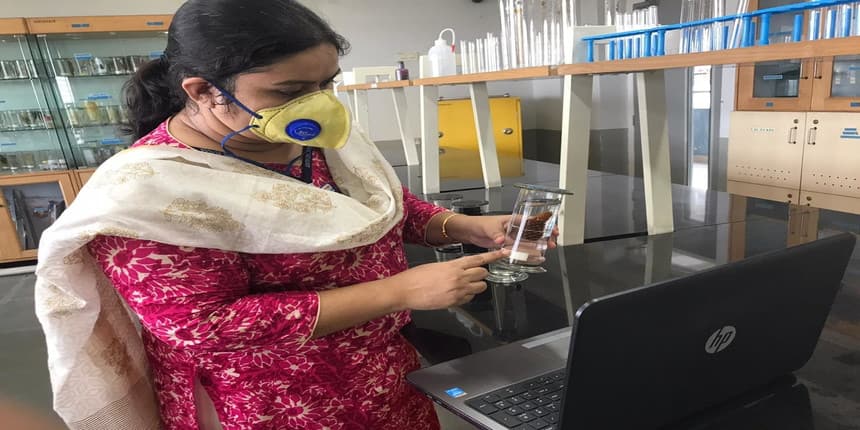One City, Two Worlds: Online classes in Kolkata’s govt and pvt schools
Pritha Roy Choudhury | July 18, 2020 | 04:51 PM IST | 4 mins read

NEW DELHI: Every morning, Avantika Thomas’ two children put on their school uniforms and settle down in their drawing room with their laptops. Classes begin at 8.30 am sharp. Their school, the private South City International School in Kolkata, has been offering online classes since March when schools shut across the state due to the coronavirus outbreak.
But since the total lockdown was lifted, teachers have been delivering the online classes from the school, using its smartboards and other facilities. Children have been asked to wear their uniforms, they get to see their classrooms, perform online experiments and follow the same routine they did before COVID-19 ravaged the school education schedule.
“I am happy now, they feel they are going to school,” said Thomas. “I have seen the happiness in my child's face, when he saw the familiar classrooms, the laboratories, the teachers performing the experiments, organising elocution and exercise classes.”
There is no simulating a classroom for students of Vivekananda Vidya Mandir, a municipal school, also in Kolkata.
The majority of its students don’t even have a smartphone and can connect with their school only via their parents. “We prepare notes and assignments to be given to the child,” said Sujata Mitra Roy, a teacher at the school. “The school makes photocopies and these are handed over to the parents when they visit the school for collecting their ration. They come back with the assignments worked on by the students on their next visit to the school.”
The COVID-19 pandemic has again thrown into relief the disparities in education. In June, a report by the United Nations Educational, Scientific and Cultural Organization, or UNESCO, stated that the strategies various governments have adopted to ensure continuity of education during the COVID-19 pandemic are “exacerbating exclusion” among students and that the technology-based strategies are “imperfect substitutes for classroom instruction”.
This was evident from Careers360 own reporting on the diverse experiences of online learning in India. As classes moved online, government school students, mostly poor, fell behind private school ones; rural students behind urban ones; girls behind boys; and the students with disabilities, behind the abled ones. The experience of online education, which requires students to have significant resources, has been vastly different across Kolkata’s private and public schools.
Private schooling at home
In Kolkata, many private schools now have teachers delivering their classes from the campuses, using the schools’ wi-fi enabled classrooms and smartboards. Wearing uniforms and recording lessons are compulsory. There is enough gap between classes to ensure children do not strain their eyes. While students of higher classes have a maximum of four classes in a day, junior classes have only two.
“It had become a little boring, attending online classes as our teachers were mostly explaining and we were just listening. Now it is more interesting,” said Arjun, a Class 7 student of South City International School.
Teachers of Lakshmipath Singhania Academy, Shri Shikshayatan School and Calcutta Girls’ High School are teaching online classes from schools.
Sangeeta Tandon, principal, Shri Shikshayatan said that they had anticipated a lockdown in March and started experimenting with teaching online. “We are trying to work in a manner by which we can bring the school to each home,” she said.
Attendance is mandatory for both the teachers and students. For teachers who do go to school, there are rules for social distancing. “A teacher comes to school only five or 10 minutes before her class starts. They need to leave the school when she is through with taking classes,” said John Andrews Bagul, principal, South City International School.
Not even a ‘simple mobile’
For Kolkata’s public schools, their teachers and students, online classes are proving to be a challenge. Most students of the government schools do not have access to even a smartphone. Online classes are being held as mandated but attendance is very poor, say teachers - echoing their counterparts in Delhi. In consequence, students are now many steps away from their teachers. Direction interaction in the classrooms has been replaced by printed handouts.
Teachers submit notes and the homework set to the school authorities through email or on WhatsApp. A staff-member then prints them out and photocopies them for distribution to parents. They are not collected daily but only when the parents come to collect food and other supplies from the schools once every week or month. Though initiatives have been taken by the schools, subjects which require practical demonstrations are the worst affected. Many teachers said there are gaps which simply cannot be closed.
“I teach computer science for higher classes and the subject requires demonstration,” explained Bibhor Mitra, a teacher. “Until and unless that is done, students will not get the concept right. If we teachers also try similar initiatives like those of private schools, it will not help. There are homes which do not have a simple mobile.”
“How can the students whose parents are not literate be helped? That is not happening,” said Ram Sahay Mukherjee president of West Bengal Primary Teachers Association.
Also Read:
Kerala to provide subsidised laptops to students: Chief Minister
Online Classes: IIT Bombay alumni donate Rs 1.5 cr for laptops, internet
Write to us at news@careers360.com
Follow us for the latest education news on colleges and universities, admission, courses, exams, research, education policies, study abroad and more..
To get in touch, write to us at news@careers360.com.